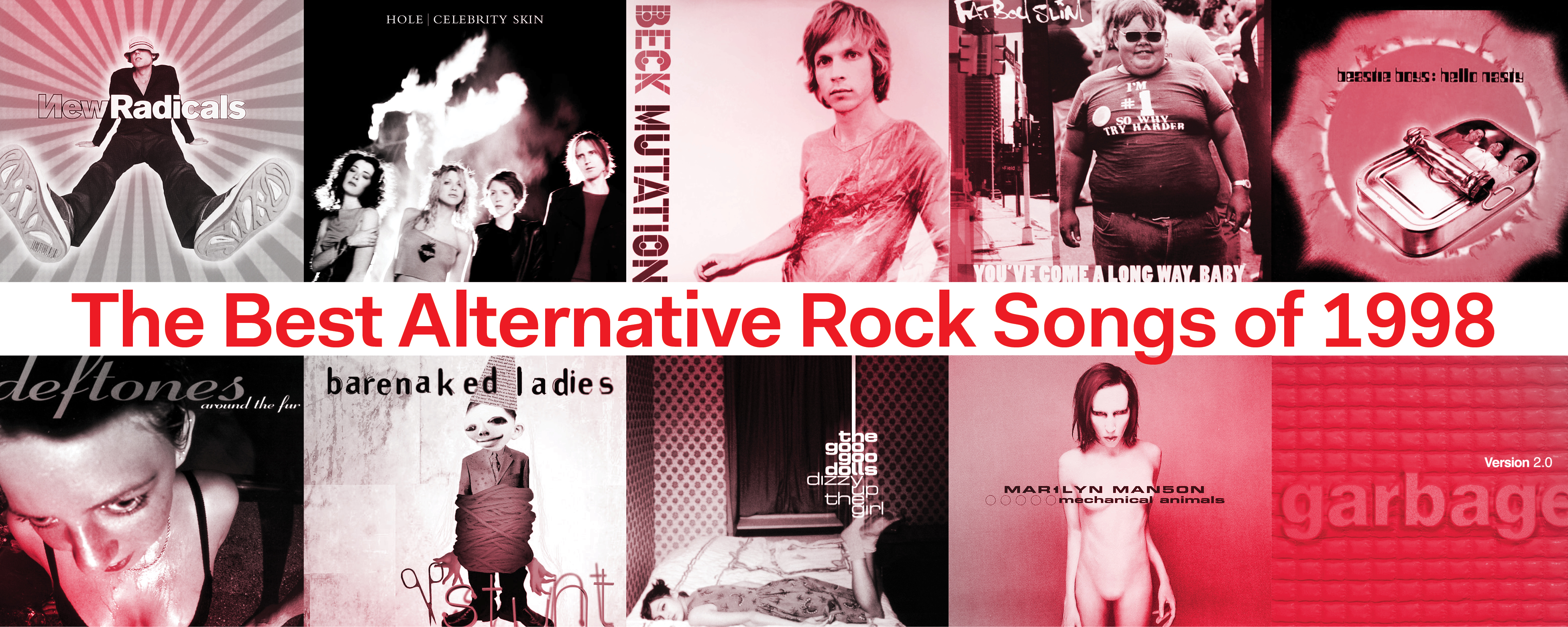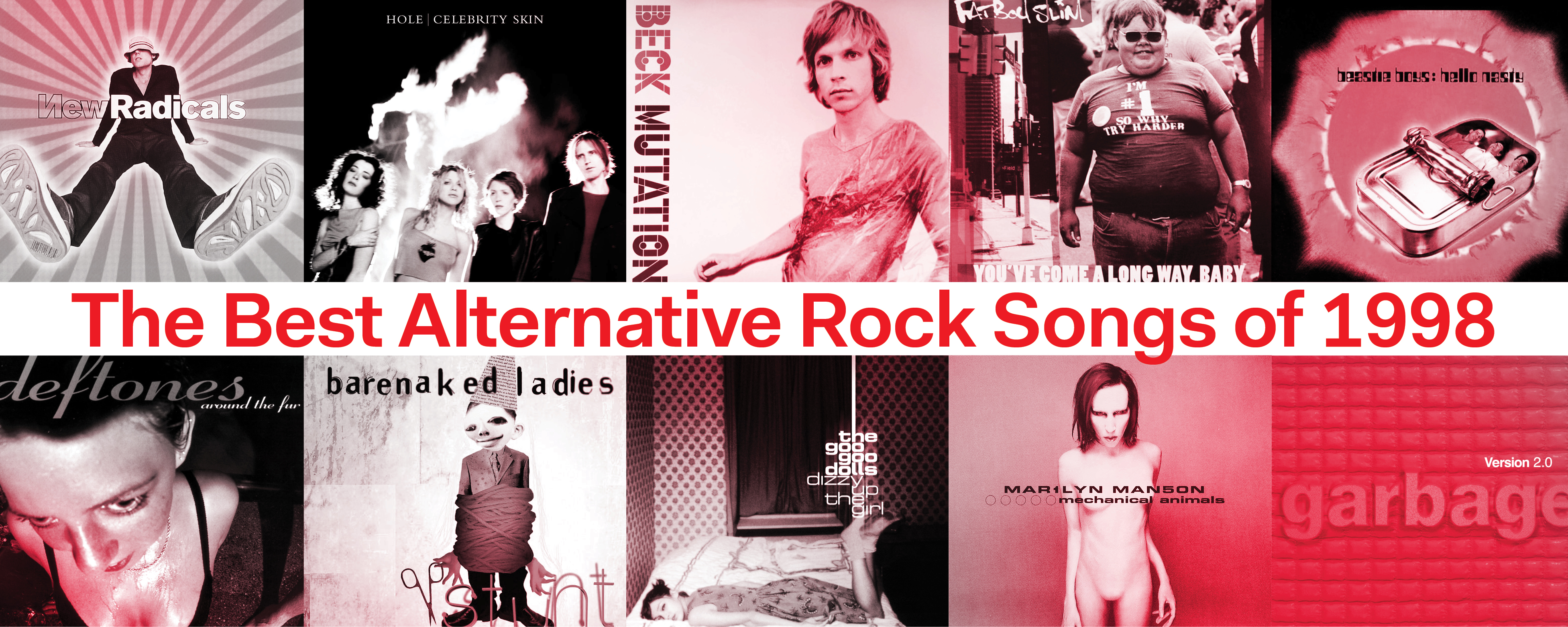20. Goo Goo Dolls – “Iris”
A love song full of earnestness and deep longing, Goo Goo Dolls’ “Iris” is indelible from its opening chords. “And I’d give up forever to touch you, ’cause I know that you feel me somehow / You’re the closest to heaven that I’ll ever be, and I don’t want to go home right now,” sings Johnny Reznik, lyrics so schmaltzy they’d be embarrassing if he didn’t sell them so convincingly. It’s the kind of song that teen dramas and high school dances were practically invented for, and its chorus (“I just want you to know who I am”) has remained lodged for decades in the minds of anyone who grew up with it. That’s a testament to the power of “Iris”—no matter how silly it may feel to sing along. —ID
19. Everclear – “I Will Buy You A New Life”
With its seemingly earnest lyrics about wooing a partner and better your situation through greater purchasing power, Everclear’s “I Will Buy You a New Life” could probably never be considered cool, exactly. But still, there’s something unexpectedly poignant about Art Alexakis’s promises to “buy you a new car, perfect shiny and new,” especially in contrast to the scenes of poverty he alludes to in the verses. In a time of jaded cynicism, a song dripping with so much hope is heartening to return to, and its chugging California power pop grooves have aged better than plenty of other music from the era. Everclear’s new life still sounds like an ideal purchase. —ID

Also Read
The Year in 1998 Alternative Rock
18. Stardust – “Music Sounds Better With You”
“Music Sounds Better With You” is the lone release from French dance trio Stardust, a one-off project headed by Daft Punk’s Thomas Bangalter. It’s a shame we didn’t get to hear more from them, but on the other hand, I get why you’d want to quit while you’re ahead after releasing an undeniable earworm that dominates dancefloors for the better part of the summer and fall. At the time, it was widely believed that the disco throwback was a thinly-veiled ode MDMA. The six-minute track only has one verse, and it’s not exactly subtle. —MS
17. Marilyn Manson – “The Dope Show”
For a while, it seemed like Marilyn Manson was angling to be the next David Bowie. His 1996 breakthrough, Antichrist Superstar, was the black swan to Ziggy Stardust’s peacock—an outré concept album about a dark messiah. Two years later, he embraced glam aesthetics, limping around in a cocaine-white androgynous alien costume on Mechanical Animals. “The Dope Show” was the theme song for this new phase, a Warholian discourse on Manson’s chief fixation—celebrity narcissism—set to a creeping, pounding synthetic beat. When the lyrics weren’t pedantic (“They love you when you’re on all the covers/When you’re not, then they love another”), they were mildly alarming: “Cops and queers make good-looking models”? But goth and glam have always been kissing cousins, and Manson’s campfire-ghost-story vocals and industrial rhythms complemented druggy reveries and stomping choruses straight out of T. Rex’s Electric Warrior. If only that fusion hadn’t been the last great idea of his too-long career. —JB
16. Korn – “Got the Life”
The arrival of Korn’s “Got the Life” coincided more or less with the inception of rap rock. The song broke records on MTV’s Total Request Live—also in the fledgling stages of its popularity—and became the first to be forcibly retired from the countdown, beating the boy bands on their home turf. The video—a bright, washed-out thing in the mid-’90s aesthetic tradition—featured cameos by relevant warhorses of the impending era: Eminem, Fred Durst, Wes Borland, the guy from Orgy. “Got the Life” is perhaps the strongest of Korn’s singles, and the first to lay out all the trademark elements of their sound. Those include a screeching single-note guitar line, a panoply of slapped bass notes, and lots of unintelligible yelped invective from Jonathan Davis. The video is a pseudo-comment on the proverbial fame monster, of which the band were just getting a taste. More than most other documents from this era, “Got the Life” still sheds a bit of light on the way this bizarre musical movement became a crossover cash cow. —WCW
15. Eve 6 – “Inside Out”
Around the turn of the millennium, alt-rock playlists were packed with bands whose shticks could be condensed to a tagline: Pervy disco slackers! Power-pop dweebs! Pearl Jam, but make it Christian! As introduced in the rain-soaked video for their debut single, “Inside Out,” Eve 6 looked and sounded as though someone had sold them as “the Trainspotting guy does O.C. pop-punk, emphasis on pop.” Nineteen-year-old Max Collins’ vocals were so dense and rhythmic, he was nearly rapping—a technique that effectively disguised both the simplicity of the chord progressions and the fact that he was saying nonsensical stuff like “SoCal is where my mind states/But it’s not my state of mind.” Eve 6 were not exactly making high art, yet “Inside Out” had (and retains) a kicky appeal. Unlike, say, modern-rock Bryan Adams, at least these kids seemed to be having a good time. —JB
14. Deftones – “Be Quiet and Drive (Far Away)”
Deftones are probably the only the band on the planet that could reasonably be described as both nu-metal and shoegaze, claiming both Helmet and Cocteau Twins as formative influences. If the second of those descriptors doesn’t immediately scan, take another listen to “Be Quiet and Drive (Far Away),” the second single from their second album Around the Fur, and the first of their songs to chart in the U.S. The guitars are warm and enveloping like a good body high, distorted in a way that has much more to do with Loveless and Siamese Dream than Follow the Leader or Significant Other. Vocalist Chino Moreno spent Deftones’ debut stomping and raging like the adolescent boy he’d just finished with being, but on Around the Fur he began to find his sensitive side, honing in on the breathy melodic singing that became his go-to style. “Be Quiet and Drive (Far Away)” is a song about a different kind of teenage feeling: falling in love, or something like it, and wanting to escape to anywhere outside your depressing hometown. Moreno’s lyrics didn’t spend much time imagining what such a faraway place might look like, but that’s OK, because when you close your eyes and listen, those jet-propelled guitars take you there. —AC
13. Everlast – “What It’s Like”
Everlast’s biggest song as a solo artist is an odd one, considering how popular it was. With its acoustic guitar, boom-bap beat, and melodic sing-rapping from the former House of Pain leader, “What It’s Like” combined signifiers from country, hip-hop, and rock. Its moody but infectious instrumental belied dark lyrics about the ugliness within the cracks of American society. In his old group, Everlast embodied an abrasive Irish-American tough guy persona. “What It’s Like” announced the arrival of a new Everlast, who channeled a different sort of gritty blue-collar sincerity, still tough but tender too. —ID
12. Semisonic – “Closing Time”
If you look at the Genius page for “Closing Time,” you’ll learn that Semisonic lead singer Dan Wilson once said the song was actually about the miracle of childbirth. If you investigate further, you might discover that Wilson has also said that he wrote “Closing Time” because he was seeking a new song to end the band’s concerts with, after his fellow band members had tired of their traditional closer “If I Run.” All of this is a wonderful reminder that we should often ignore artistic intention in favor of our own interpretations. “Closing Time,” of course, is not about, or for, any of those things, if you ask me, you, or anyone we know. It is instead one of the decade’s greatest wistful drinking songs, written explicitly for the time of the night when the bar is closing and you don’t want to go home alone. As a soundtrack to that moment, the song’s literalness requires you to drop all pretension and get swept up in the saccharine corniness. That’s easy enough to do when Wilson sings “take me home” with his melancholic lilt, his voice evaporating into the air. —JS
11. Sixpence None the Richer – “Kiss Me”
The commercial success of “Kiss Me” in inextricably tied to its prominent placement in both She’s All That and Dawson’s Creek, so much so that the music video for the song was released in two different versions: one featuring the band sitting on a park bench and watching scenes from the Freddie Prinze Jr. teen comedy, another featuring the band sitting on a park bench and watching scenes from the James Van Der Beek teen melodrama. But as a pop song it stands on its own, with a perfectly breezy chord progression and lyrics filled with surprisingly vivid impressions of chaste and wide-eyed young love. Partners kiss in bucolic scenes by the “the bearded barley” and “beneath the milky twilight,” then follow “the trail marked on your father’s map.” It’s a simplistic vision of romance suited to the movie and TV show that made it famous, but those literary details elevate it, suggesting that the band knew exactly what it was doing when it crafted its fantasy world. —AC




